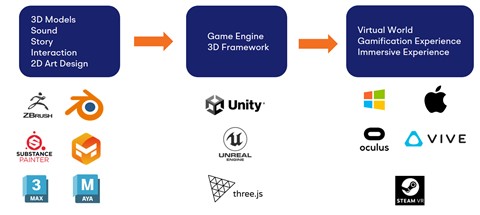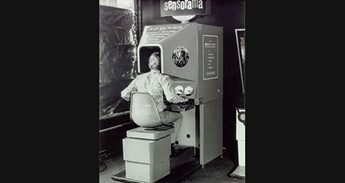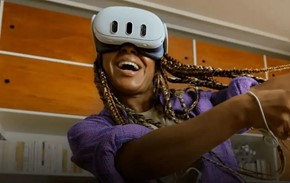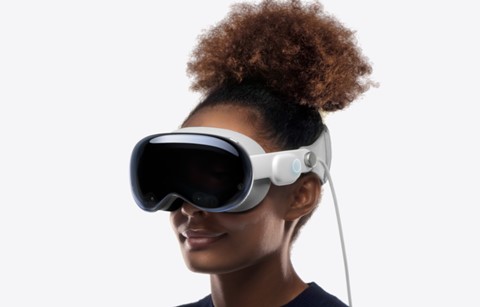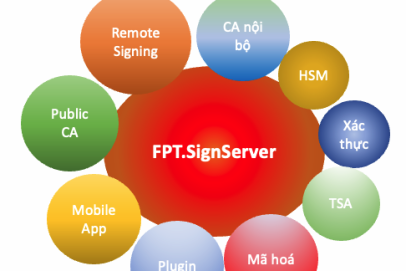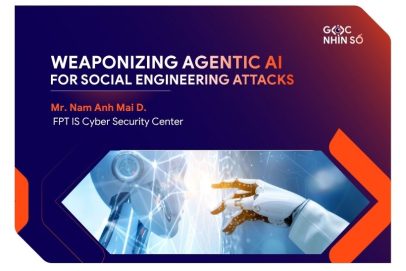VR/AR – What do business leaders need to know?
What’s VR/AR?
The current world is limited in physical constraint; people are expanding their space into virtual space, which can scale infinitely. That’s when the term Extended Reality – XR comes into play.
https://www.gao.gov/products/gao-22-105541
The term Extended Reality – XR describes a group of technologies that link or integrate digital content with the physical world, which include Virtual Reality (VR), Augmented Reality (AR), and Mixed Reality (MR)
Virtual Reality (VR) is the technology that completely takes over your vision to give you the impression that you’re somewhere else. This technology usually comes with a head-mounted display called VR Headset. It blocks out your surroundings when you wear them. When the headsets turn on, the LCD or OLED panels inside are refracted by the lenses to fill your field of vision with whatever is being displayed. It can be a game, a 360-degree video, or a virtual space from any creative mind. Visually, you’re taken to wherever the headset is set out for you, and by you, the outside world is replaced with a virtual one. Some popular VR headset brands are Meta Quest, Pico, and HTC.
As the name implies, Augmented Reality (AR) is the technology that augments your current environment. While VR replaces your vision, AR adds virtual, digital information into your vision. By adding these, the person who experiences AR can feel more natural when interacting with the virtual content. Although Microsoft HoloLens and Magic Leap are AR headsets, AR technology can often be seen in mobile devices like smartphones or tablets. These devices act as lenses to overlay digital content onto the physical world. Like VR, AR content can be anything from furniture sets, virtual pets, jewelry, and household appliances.
Mixed reality (MR) also imposes content into the real world using a concept similar to AR. However, instead of being more static, the MR content is more interactive and responsive according to the surroundings. For example, the ball you throw at the wall will vanish into the wall in AR but bounce back in MR. MR technology often involves many techniques, such as 3D scene reconstruction, Machine Learning, and Computer Vision, to achieve that responsiveness.
Why VR/AR?
Understanding the concept and the capability of VR/AR technologies, we can clearly see that they have so much potential as the virtual world is infinite.
Infinite Space: The world is getting more and more crowded. But people still need much space for work, showcases, and entertainment. We will not be limited to physical space in the virtual world.
Infinite Creativity: The real world is limited to Newton’s law of physics. The virtual world can bring new ideas to life that you can only have in your imagination. If you can think of any new crazy idea, do it in the virtual world.
Safety with Simulation: VR/AR can create a very unique scenario in the virtual world, resulting in a simulation that is usually impossible in real life due to life-threatening or hazardous elements, which can safely deploy to the users.
Re-useability: Since it’s a virtual world, the space can be used multiple times without depreciation. Physical equipment and facilities need to be replaced and renovated over time. But virtual space can last forever, the virtual equipment is hardly worn out.
The resource is usually a finite amount. Having something infinite is itself a huge win for everyone. That’s why scientists and engineers continue researching and applying these technologies to more and more industries and various purposes.
How do industries apply VR/AR technologies?
For now, VR/AR has been used for many purposes in industries. But I would like to mention 3 common ones:
-
Education and Training
Education is one of the most significant areas to benefit from the arrival of VR/AR technology. In 2020, when the COVID-19 pandemic hit, teachers began searching for new ways to interact with and educate their students. Video conferencing and online collaboration tools have gained popularity. However, VR allows students to enjoy a more comprehensive hands-on learning experience. Industrial employers can also use VR/AR to improve their employees’ training sessions in various ways.
The manufacturing plant can have its engineering staff training new operation lines. Car manufacturers can provide training to fix their own car parts to the mechanic. Airplane companies can provide their maintenance and overhaul procedures to VR since it will cost less physical space and equipment. Fireman is trained in a very hard-replicated real-world scenario involving life-threatening elements. Construction sites can have the driver operate the vehicle virtually before going to the construction site.
According to Allied Market Research, the virtual training and simulation market size was valued at $204.41 billion in 2019 and is projected to reach $601.85 billion by 2027, growing at a CAGR of 13.7% from 2020 to 2027 [5].
-
Entertainment
You step into another virtual world when you put on a VR headset. Since VR usually covers up your vision, sometimes your brain cannot tell you the difference between real and unreal. This immersion is why VR is so great for the entertainment industry – imagine being outside of space or hanging out with some anime characters you only read in comics.
By utilizing this entertainment aspect, the Gaming industry captivates this concept quickly, followed by the Music industry with Concerts and Performances, and then the Sports industry.
According to Grandview Research, the global virtual reality (VR) market size was estimated at USD 59.96 billion in 2022 and is expected to grow at a compound annual growth rate (CAGR) of 27.5% from 2023 to 2030 [3].
-
Visualization and Collaboration
Also impacted by the COVID pandemic, many locations cannot be visited. That’s when VR/AR brings out its strength in visualization, such as remote touring, virtual collaboration, designing new products, and controlling remote robots or vehicles.
Real estate, tourism, galleries, and exhibitions can have visitors online via VR. Agency, Office, and Freelance can also work remotely with customers in VR.
How do you create a VR/AR experience?
Creating a VR/AR experience is similar to creating a game. That means the whole process is a work of art. This process can differ case by case, but it can be generalized into the following part:
- Asset Creation: In this part, you must create a lot of materials, including 3D design, 2D design, UIUX design, Graphic design, etc. Various tools will be created by various tools. For 3D, you can have Blender, Autodesk 3DsMax, ZBrush. For 2D and graphic design, you can use Adobe Photoshop, Adobe Illustrator. For UIUX Design, Figma, Balsamiq are often mentioned
- Logic Implementation: After creating materials, you will program logic for your experience. To create this logic, it’s usually involved much knowledge in 3D graphics. It’s very difficult to create these VR/AR experiences from scratch. That is why engineers often use Game Engine to support in this process. There are many Game Engines available on the market, however, the 2 most popular are Unity Engine and Unreal Engine.
- Platform Deployment: VR/AR experience is technically an application. It will need a platform to deploy on. These platforms can be PC, Mobile, or some VR headsets.
The duration of this process is determined by the complexity of the content and the amount of assets you need to create that experience. Currently, the most time-consuming part is asset creation. Imagine building a house in virtual world, you will need to 3D model the house, the furniture. The effort to create these models is somewhat bigger compared to arranging these models into a virtual house. Engineers, 3D Artists, and 3D Designers often re-use these assets or create multi-purpose assets to minimize the effort needed to re-create them, but that’s not always the case. Sometimes you must go extra miles to create a very delicate 3D model.
The gain in popularity of VR/AR applications also led to the fact that companies and agencies recruit more people in Design like 3D more often. Also, technical positions like Unity Engine/Unreal Engine Developer, AR developer are getting more attention nowadays.
What’s the current challenge in VR/AR?
Although it has many advantages and benefits, the VR/AR industry faces several challenges that are hindering its growth and widespread adoption. Here are some of them.
VR Headset is not yet comfortable enough
From the very first VR system in 1962 [6], The Sensorama is very big and looks like an ATM. Right now, the standalone VR headset is very packed and well rested onto your head such as the latest Meta Quest 3. However, people still find it very bulky and heavy. It’s still not comfortable enough for commercial users to fully embrace its charms.
(Sensorama in 1956)
(Meta Quest 3 in 2023)
With ergonomic design and the fast-paced development of hardware and chips, VR headsets are expected to get smaller and smaller to the point that people can wear them comfortably like normal glass.
Technical Specification is still very challenging
Not only bulky, but the headset is also very much limited in terms of technical specification. The resolution, while being comparatively high, is still not good enough. People still experience motion sickness and dizziness. VR headsets also last about 2-3 hours, which is good enough for longer usage in the industry.
| VR Headset | Resolution | Refresh Rate | Field of View | Battery | Weight |
| Meta Quest 3 | 1832 x 1920 per eye | 120 Hz | 120 degrees | 2 hours | 571 g |
| Meta Quest 2 | 1832 x 1920 per eye | 90 Hz | 100 degrees | 2-3 hours | 571 g |
| Sony PlayStation VR2 | 1920 x 1080 per eye | 120 Hz | 100 degrees | 2-3 hours | 600 g |
| Valve Index VR Kit | 1440 x 1600 per eye | 120 Hz | 130 degrees | 2 hours | 809 g |
| HTC Vive Pro 2 | 2448 x 2448 per eye | 120 Hz | 120 degrees | 2-3 hours | 770 g |
| Meta Quest Pro | 1832 x 1920 per eye | 90 Hz | 100 degrees | 2-3 hours | 571 g |
| Pico 4 | 2160 x 2160 per-eye | 90 Hz | 104 degrees | 3 hours | 586 g |
| Apple Vision Pro* | 3400 x 3400 per eye | 90 Hz | 120 degrees* | N/A | 453 g* |
*This information is based on announcement and rumor, not the actual specs
(Apple Vision Pro)
Apple Vision Pro is the most anticipated MR headset that was announced in June 2023. It’s expected to have better sensor and better resolution and better tracking. With the ergonomic design, Vision Pro will create a better user experience and help users in the transition of this technology in the future.
The pricing is not for everyone
The cheapest VR headset you can buy in 2023 is Meta Quest 2 starting from $299. Follow up by mid-range around $500 to $1500. The most expensive headset is Vision Pro from Apple, it would cost $3500.
| Meta Quest 2 | $249 |
| Pico 4 | $430 |
| Meta Quest 3 | $499 |
| Sony PlayStation VR2 | $599 |
| Meta Quest Pro | $999.99 |
| HTC Vive Pro 2 | $1,399 |
| Valve Index VR Kit | $1,490 |
| Apple Vision Pro | $3,499 |
These pricing are very expensive compared to the use case it brings to the commercial users right now. That’s why most of the applications (except entertainment) are applied for professional environments.
What could business do to make the adoption?
With its potential, VR/AR technology is the way to go into the future. However, the skeptical, the cost, and the use cases are currently holding back onto the decision of the business leader. As an Innovator in corporation, leader can set out some key step to gradually and carefully transition as following:
Define what process can be virtualized
There are many processes in corporations that are so complex and resource consuming. But not all the processes can fit with the VR/AR technologies at the moment. You need to pick out a few processes and try out certain steps gradually in multiple Proof of Concept projects. With this action, you gradually test out the transition of this new technology.
Try out small and quick solutions to experiment with PoC
With many agencies, platforms, solutions, companies can experience VR/AR technologies in a small and quick fashion. By win fast or lose faster strategy, you can easier shape your company’s current business to fit in with VR/AR technology. Also, it has potential to set out a new company market if you can find the right solution to the right problem.
Seek advice from experts of the field
VR/AR industry is a relatively new field of technology. Seeking advice from experts in the field can help you analyze better your current business and find out the right sector to apply VR/AR technology. Fastening the problem identification process can also help you a lot in applying VR/AR into your business.
Take away
VR/AR technology is a fast-growing industry. The straightforward advantages are very clear and the potential to enhance, optimize, and expand to the current business is vast. While having certain drawbacks, businesses are encouraged to look for the right solution and apply it to the right problem so that the companies don’t fall too far from the world’s latest technology.
The world is shifting to the infinite space of virtual reality.
References:
[1] https://www.gao.gov/products/gao-22-105541
[2] https://www.xrtoday.com/mixed-reality/the-top-6-industries-for-enterprise-ar-vr-in-2021
[3] https://www.grandviewresearch.com/industry-analysis/virtual-reality-vr-market
[4] https://www.mordorintelligence.com/industry-reports/virtual-reality-vr-market-in-education
[5] https://www.alliedmarketresearch.com/virtual-training-and-simulation-market
[6] https://virtualspeech.com/blog/history-of-vr
[7] https://vr-compare.com/
[8] https://www.apple.com/apple-vision-pro/
Exclusive article by FPT IS Technology Expert
Do Son Tung
Senior Expert
FPT Information System Company.



